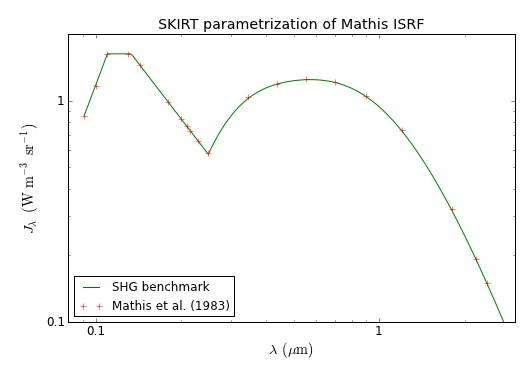 |
The Stochastically Heated Grains Benchmark
|
 |
The Stochastically Heated Grains Benchmark
|
The exact choice of dust grain model is not critical for benchmark purposes, as long as all codes employ the same model. Specifically, our choices do not imply a preference for or an endorsement of a particular model. We have elected to utilize a simple mixture of spherical, single composition graphitic and silicate dust grains. Further details are provided in the paper.
The data files defining the dust properties used in this benchmark can be downloaded from the Downloads page. The DustModel directory contained in the provided archive is organized in the following subdirectories:
GrainInputs : optical and calorimetric properties for each of the three grain types \(k\). Optical properties include the absorption and scattering efficiencies \(Q_k^{\mathrm{abs,sca}}(a,\lambda)\) and the scattering asymmetry parameter \(g^\mathrm{asym}_k(a,\lambda)\), tabulated on a grid of 1201 wavelengths \(\lambda\) and 28 (for PAH) or 121 (for graphite and silicate) grain sizes \(a\). Calorimetric properties include the specific enthalpy \(h(T)\) [erg/g] and the specific heat capacity \(c(T)\) [erg/g/K] of the grain material, tabulated on a grid of 1000 temperatures \(T\). The calorimetry data for graphitic grains should be used for PAH molecules as well.SizeInputs : tabulated grain size distributions \(\Omega_k(a) \,[\#_\mathrm{D}\,\mathrm{cm}^{-1}\,\#_\mathrm{H}^{-1}]\) for each grain type \(k\), on a size grid with 24, 62, and 63 samples for the PAH, graphite, and silicate component, respectively. Implementations may choose to compute the size distribution from the functional form defined in the paper, or to load the tabulated data.EffectiveGrain : size-integrated values of the optical properties. This data can be used for "quick and dirty" equilibrium-only calculations of the dust emission spectrum, using a single "effective" grain type to represent the grain population.ScatMatrix : scattering matrix elements. This information is not needed for calculating dust emission.
In this benchmark the dust grains are exposed to two sets of distinct radiation fields. The first set consists of eleven scaled versions of the solar neighborhood interstellar radiation field (using a parametrization defined in the paper; see also figure above), ranging from weak to strong as follows:
\[ J^{\mathrm{SHG},i}(\lambda)=U_{i}\times J^{\mathrm{Mat}}(\lambda)\;\mathrm{with}\, U_{i}=10^{-4},10^{-3},...,10^{5},10^{6} \]
The second set consists of six diluted black body fields with varying temperatures, ranging from soft to hard as follows:
\[ J^{\mathrm{SHG},j}(\lambda)=\begin{cases} 8.28\times10^{-12}\,B(\lambda,3000\,\mathrm{K}) \\ 2.23\times10^{-13}\,B(\lambda,6000\,\mathrm{K}) \\ 2.99\times10^{-14}\,B(\lambda,9000\,\mathrm{K}) \\ 7.23\times10^{-15}\,B(\lambda,12000\,\mathrm{K}) \\ 2.36\times10^{-15}\,B(\lambda,15000\,\mathrm{K}) \\ 9.42\times10^{-16}\,B(\lambda,18000\,\mathrm{K}) \\ \end{cases} \]
where the Planck function is given by
\[ B(\lambda,T)=\frac{2hc^{2}}{\lambda^{5}}\frac{1}{\exp(\frac{hc}{\lambda kT})-1} \]
The following table lists the precise values of the relevant physical constants as they were used for the calculations presented in the paper and on this web site.
| Symbol | Description | Value |
|---|---|---|
| \(c\) | Speed of light in vacuum | \(2.99792458\times10^{8}\,\mathrm{m/}\mathrm{s}\) |
| \(h\) | Planck constant | \(6.62606957\times10^{-34}\,\mathrm{J}\,\mathrm{s}\) |
| \(k\) | Boltzmann constant | \(\mathrm{1.3806488\times10^{-23}\, J}/\mathrm{K}\) |
The codes participating in this benchmark calculate the spectral dust emissivity \(\varepsilon(\lambda)\) for a population of dust grains with the properties of the dust model described in Dust model, for each of the input radiation fields specified in Input fields. The radiation emitted by the dust itself is ignored with respect to the input field, i.e. it is not the intention to calculate a self-consistent radiation field. The calculations are performed, and the results written down, using the wavelength grid on which the optical properties have been tabulated. This is a logarithmic grid with 1201 points in the range \(0.001\,\mu\mathrm{m}\leq\lambda\leq10000\,\mu\mathrm{m}\).
The data files representing the benchmark results can be downloaded from the Downloads page. For each participating code, the output for each input radiation field is stored in a separate text file with one the following naming schemes, depending on the type of field:
where \(\left<code\right>\) stands for the name of the code that calculated the result, and \(\left<soltype\right>\) indicates the solution type as listed in the table below.
| Section | \(\left<soltype\right>\) | Calculation regime | Grain size distribution | Grain properties |
|---|---|---|---|---|
| Full Solution | SHG | stochastic heating | as defined in dust model | as defined in dust model |
| Single Grain Solution | \(\mathrm{S\_}\left<nnn\right>\) | stochastic heating | all grains have size \(nnn\) Å | as defined in dust model |
| Equilibrium Solution | EQU | equilibrium only | as defined in dust model | as defined in dust model |
| Effective Grain Solution | EFF | equilibrium only | single "effective" grain | single "effective" grain |
Each file has a simple column-based text format as described here. Any initial lines starting with a # character are considered to be comments and thus are ignored when reading the data. Other than this header, the file contains 1201 lines, one for each wavelength in ascending wavelength order. Each line contains five or more numbers separated by whitespace, specifying the wavelength \(\lambda\) (in \(\mu\mathrm{m}\)); the mean intensity \(J_\lambda\) of the input field (in \(\mathrm{W}\,\mathrm{m}^{-3}\,\mathrm{sr}^{-1}\)); and the silicate, graphite and PAH emissivities \(\lambda\,\varepsilon_\lambda\) (in \(\mathrm{W}\,\mathrm{sr}^{-1}\,\#_\mathrm{H}^{-1}\)), in that order. Any information on a line beyond the first five numbers is ignored when reading the data.